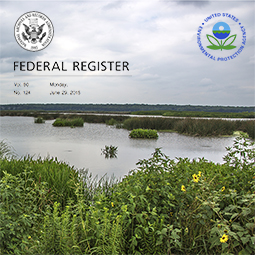Blog
A Federal District Court Issues First Decision Regarding New “Waters Of The US” Regulations
-In this post, "Waters of the United States" webinar instructor Larry Lodwick explains the latest about the temporary injunction on the EPA's new federal clean water rules. For full information about the latest on this, and details of the Rule updates, enroll in the upcoming webinar.
On August 28, the U.S. District Court in North Dakota issued a temporary injunction against new federal clean water rules from going into effect on Friday, August 28, 2015 until a legal challenge has been resolved. This was a temporary victory for 13 states that have strongly opposed the regulations. The preliminary injunction was against the so-called Waters of the United States rule that was published by the Environmental Protection Agency.
Critics contend the rule vastly expands the federal government's authority and could apply to ditches and small isolated bodies of water. Many of these areas are already regulated under the existing clean water act permit program. Another argument was that the regulations surpass the Congressional intent. However, the Supreme Court decisions require the consideration of whether a significant nexus exists between many small and isolated water and more traditionally jurisdictional waters, which extends beyond Congressional intent.
The intent of the rule was to clarify which waters are covered by the federal Clean Water Act, after two major Supreme Court rulings and subsequent guidance modified the existing regulations and how they are interpreted. There are significant changes involving new boundaries or distances from traditionally regulated waters, called “bright lines” designed to clarify which waters are regulated. There is also new dependence on the 100-year floodplain in determining the “bright lines”. The new rules do not change the way permit decisions are made or change how permits are issued. They also do not change the determinations of the limits of waters in terms of ordinary high water mark or high tide lines, nor do they change the definition of wetlands, or the way wetland boundaries are determined. An interesting point is, while claims state that the new regulations would expand federal jurisdiction, if one considers how jurisdiction is currently determined, based on guidance issued after the Supreme Court decisions, how much would the new regulations actually add.
North Dakota along with Alaska, Arizona, Arkansas, Colorado, Idaho, Missouri, Montana, Nebraska, Nevada, New Mexico, South Dakota and Wyoming are the states that filed a lawsuit against the federal government charging that the rule constituted an improper expansion of its powers. Some other States have challenges to this regulatory action in appellate courts. EPA said in a statement that the court's order would only apply to the states involved in the North Dakota decision.
EPA stated the rule does not create new permitting requirements and only seeks to make jurisdictional determinations more predictable. EPA is considering its next steps in the litigation.
Stay tuned for updates to this story.
For more information about the changes and clarifications to the regulations, enroll in our "Waters of the United States" webinar.
Headlines
The City of Portland, Oregon invites applications for the position of Site Development Inspector I
CITY OF PORTLAND invites applications for the position of:
Site Development Inspector I
The City of Portland, Oregon invites applications for the position of Site Development Inspector I
CITY OF PORTLAND invites applications for the position of:
Site Development Inspector I
*Follow NWETC on twitter, and "like" us on Facebook by clicking the icons:
© 2026 NWETC. All rights reserved









